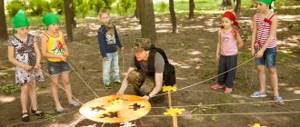In this article we will discuss with you the psychology of human fear and directly relate it to the opening of a horror quest. The information will help you understand fear technologies a little better, as well as understand the basic mechanics of horror quests.
Today, horror quests are perhaps, if not the most popular quest genre in the world.
, then it is definitely no further than second place. In Kazakhstan, for example, people mainly go only to horror films. In Russia, horror films are popular mainly in big cities, but in the regions they have also been rapidly gaining momentum for the second year now.
People like horror quests because the emotions here are much brighter and stronger than in other genres of quests in reality. Yes, in the adventure quest you became the fateful saviors of all humanity, saving the world, and you can be content with the status of “hero”.
Meanwhile, in hard-core horror films, people are in an insane state of fear, rushing from room to room from the actor, and adrenaline is produced in large doses every few minutes. They are not heroes, they are victims, and they just want this nightmare to end. And then they return there again, because horror for some people is worse than any drug.
Features of the quest
This quest is based on a humorous detective plot - a complicated story with the mysterious disappearance of gifts.
Players receive a letter from the Master of the house describing the incident, as well as a dossier on all suspects. The owner asks you to help him solve the crime, otherwise the holiday party will be ruined.
From this moment on, players will have to turn into detectives: study the case materials, find all the clues during the game and identify the thief. You can't do this without intelligence and attention to detail.
Players will have to show logic, deduction, attentiveness and ingenuity to expose the kidnapper. Tricky puzzles, funny riddles, encryption and logical tasks will help players eliminate the innocent step by step. Players will never be bored!
Suitable for black and white printing, since solving puzzles does not depend on color.
With the help of the entertaining detective quest for adults “The Case of the Stolen Gifts” you can:
- quest for one player, for example, on a free Sunday evening to entertain a loved one with an interesting intellectual game
- quest for one team of players at a family holiday or at a friendly party
- a game as a competition between two teams, for example, to test the erudition of men on February 23
- a holiday game for teams without competition, with prizes for each team, for example, at a New Year's party
Age of players
The entertaining detective quest for adults “The Case of the Stolen Gifts” is intended for adults , but there is nothing dark or vulgar in it, so children can take part in solving some of the puzzles, and the quest can become general entertainment at a family holiday.
Venue of the detective quest for adults “The Case of the Stolen Gifts”
This is a universal quest, it is suitable for conducting in any place - indoors (in an apartment, in a private house, in a cottage, in an office, in a holiday home, in a cafe) or outdoors (in a country house, in a village, in the courtyard of a private house or Outdoors).
For the role of hiding places, the kit offers two ready-made search chains: for conducting the quest at home and on the street (in the courtyard of a private house or on a summer cottage). If you want to use other places or you need to organize a quest for several teams, it is possible to create the desired search chain using a special decoder - for this you need to edit just one page in the template.
What should be in the hardest horror?
Correct lighting
It should not be bright under any circumstances. Horror quest is darkness, it is barely visible light, it is dimness and tension. Rooms immersed in darkness and gloom, poorly lit corridors. Lighting that keeps disappearing and then suddenly coming back.
It's terrible for a horror movie to have light in the rooms. Where is the fear? Human psychology is built on the fact that we are afraid of the dark because of the unknown. We have had this since ancient times, when we hunted wild animals and were afraid of dark, special enclosed spaces. The situation is much more difficult to control, because we always need time to retreat.
The light is dim, but it is on, the room is more or less visible, the situation is under control. But suddenly, the lights go out completely, the music becomes more intense, and it seems that someone's breathing can be heard at the end of the room. Control is lost. Panic begins and adrenaline is produced. And then endorphin.
Musical accompaniment
It must be incredibly scary. We, at SQR60, when developing horror, very often make gestures and become more and more immersed in this madness together with our future quest visitors. Therefore, the musical accompaniment turns out to be so terrible that even our hair stands on end when sitting in front of our computers in a cozy office, and the sound engineers then have trouble sleeping at night.
In reality quests in the horror genre, you simply need to invest in a powerful soundtrack: scary compositions, howling voices, various special effects in the background from steps to heavy breathing, clapping, grinding and much more. Our library contains more than 1 terabyte of audio material for all occasions, so if you need a script and/or voice acting for a horror film, you are right at the right place.
Here are just some examples of voice acting for our horror films. Attention, it is better to keep it quiet, you will be scared:
3 voice acting styles for horror quests:
The gloomy cry of a girl from the telephone receiver:
Players coming out of coma:
A horror quest without musical accompaniment can only be successful if it is a performance.
Musical accompaniment in the quest
Basics, nuances, tips. It's all about how to properly immerse players in the story with the help of sound.
Read + listen
Props
To immerse you more deeply into the reality you create, you also need to invest in props. If, according to the plot of the quest, your apartment is after a fire, then there should be traces of burning and soot on the walls. The furniture must be partially burned and destroyed.
One day, a good friend of mine from Germany told me that there was a huge fire on the first floor of his dormitory. He himself lived on the fourth floor, and he was evacuated through the balcony when firefighters came to help. It was in the morning, so after the whole day, late at night, he and his friends decided to return there to pick up their things from the surviving apartments. And judging by their description, it couldn’t even be closely compared to quests - the fear was literally animalistic, very real. Everywhere there are black, peeling walls, destroyed furniture, a lot of rubbish and fragments. The ringing silence is sometimes broken by some strange rustling sounds. Perhaps the corridor they passed at the entrance was the “longest” and most unbearable in their entire lives.
And the fear was, in fact, not because there could be looters or anyone else there. Not because the dorm was sealed and it was impossible to return there for several days. And because black colors, and even without lighting, put a lot of pressure on the psyche. Especially considering that a person’s “life experience” turns on - subconsciously we remember that similar scenes in films, games or even books ended very badly.
Today in Russia there are many talented prop makers. Do you want a realistic corpse so as not to be distinguished from the real one? No problem. What about severed fingers made of silicone? Yes, in a few days. Blood that looks like it’s real, and not pink and not the consistency of ketchup? Will.
If you have a minimal budget for opening an quest room, and there is no possibility of cooperation with a prop maker, then simply paint the walls a dark color and make the rooms with minimal lighting. This is a universal tip and you can never go wrong, and it applies to 9 out of 10 scenarios.
Here’s another life hack for you, and it’s simply called realism.
If your quest recreates the atmosphere as if a brutal bloody murder took place in the room, then try to reproduce it and reflect it in props. How exactly was the victim killed in the quest plot? With a knife? Where exactly? Will the blood flow immediately, or a little later? What will the victim do? Will it fall to the floor? How exactly? What will happen to the blood? Furniture, things? How exactly should they fall during the confrontation between the killer and the victim for the players to believe that there really was a fight to the death here?
Players love little things, references to something, “Easter eggs”. If you bother so much, then be sure that attentive participants and pedantic fans will appreciate your efforts.
But realism is not so difficult to achieve. To better understand, adopt and implement this trick specifically for horror quests, be sure to watch the film “Gone Girl.”
Special effects
What is called a “screamer” is powerful, sudden and chilling special effects that make a horror quest truly scary and interesting. A strong rumble in the next room, a sudden flow of cold air in a narrow corridor, a projection of a ghost on the ceiling, a female silhouette in the mirror, blood dripping from the ceiling, a ceiling falling on players, or an elevator whose floor collapses and players fall into the elevator shaft - all these are special effects, strengthening and complementing the quest. One of the main mistakes of quest makers is the emphasis in horror on riddles instead of effects.
Remember that they go to horror for a-d-r-e-n-a-l-i-n-o-m! In my memory, a dozen horror games have been ruined simply because there were incredibly difficult or tedious riddles at the very end. The whole quest was filled with intense emotions, they tried to stab us, set us on fire, we hid and ran away. And at the end we sit and almost solve equations together with the actor. But the brain resists; after all, it is scared; the ancient instinct “fight or flight” is triggered.
As a result, dissonance and loss of bonus points that quest givers could earn from combo emotions. The quest was supposed to end with an “epic explosion,” but their dynamics were completely cut off.
We'll tell you more about bonus points later.
Sometimes, when inventing and implementing special effects, we try to completely turn off common sense - that’s when the questroom scenario turns out to be as tough as possible. And one day, as part of one of the brainstorming sessions for a horror quest, our sick brain came up with a meat grinder inside the kitchen sink, where, according to the plot, the player needs to get the key from the bottom of the pipe. As soon as he grabs the key, his hand is instantly grabbed by a special device, after which a terribly loud mechanical sound is heard - the sound of a rotating meat grinder. The pipe begins to vibrate to convince the player that the meat grinder is actually about to start shredding his hand.
The player instinctively begins to panic - he wants to suddenly pull out his hand, but the mechanism works in such a way that the hand can only be pulled out slowly and carefully. It's like a swamp or quicksand, where haste will only make the situation worse. The player whose hand is inside the “meat grinder” begins to scream heart-rendingly (of course, out of fear, the installation was completely safe and not dangerous), and desperately tries to pull his hand out, and blood shoots out through a special compartment from the same pipe under the pressure of the pump.
The victim begins to scream even louder, and those who are especially impressionable even think for a few seconds that it is their own blood. Other players, in turn, pick up this heart-rending scream - from the sudden sound, from the scream of their comrade, from the blood that reaches them. Now imagine that the lights suddenly go out and ten meters from the kitchen a door opens with an actor in the lead role...
We used this technique literally once, and you can be sure that the players were as happy and satisfied as possible with this wild thing. The blood, by the way, was of course fake and was easily washed off, plus all the players wore special raincoats.
| Special effect | Price | Implementation complexity |
| Falling pan | Cheap | Low |
| Living picture/mirror | Average | Low |
| Animatronic | Expensive | High |
| Faulty wiring | Average | Average |
| Blood dripping from the ceiling | Cheap | Low |
| Bloody meat grinder | Average | High |
Story line.
The plot in a horror quest is important.
One day a customer came to us with the following problem: his clients were not afraid when going through his quest room. One minute was enough for us to understand what the main reason was. Without even opening the quest room script. According to the plot, the players in the quest are hunted by killer robots. Did you feel scared after reading it? Hardly.
Any classic horror movie with a maniac in the title role would be more banal, but also scarier. In pursuit of uniqueness, the customer, who, by the way, came up with the script on his own, made a major miscalculation - he chose the wrong topic. And he built the wrong quest, investing about a million rubles. I saved 30,000 - 75,000 on specialists, but the profit lost in a year of work was already 10-15 times more than what was saved. If you want a quest as a business project, and not as a hobby, to educate cultural heritage and other “blah blah blah”, then it is better to diversify the risks.
To simplify everything, we have acquired and unconscious fears. If you have not been afraid of dogs all your life, but one day one of them bites you badly, fear will appear, and perhaps even panic. Fear of the dark, closed space, insects can be either unconscious or acquired, and then conscious.
But how can we be afraid of killer robots if we have no experience interacting with robots in real life? To the cinema? We are afraid of maniacs because they are real. We are afraid of mysterious mystical stories, if only because we want to believe in them, and they are very plausible. But fear of robots... For this feeling to be strong, stable and live among us, humanity will need more than one hundred years.
Are you afraid of cucumbers? Horror quest where a cucumber is trying to kill you. Cucumber only scares me when it's pickled and I wash it down with milk.
The plot of the quest “Pet” deserves special attention. Just look at the story trailer:
Here we have everything we need for excellent marketing: the plot, the narrative, the denouement, the motivation of the main character. Will such a quest be more popular than the standard one: “You’ve been kidnapped by a maniac, you only have 60 minutes, time has run out!”?
The horror storyline must be thought out to the smallest detail. The main characters must have motivation. The same goes for the villains. Otherwise, it will be like in classic horror films - “honey, there’s someone walking around in our living room, don’t call the police, I’ll go check it myself, and I won’t even turn on the light.”
Actor play
This is a special point that everyone, unfortunately, implements as they wish. Why "Unfortunately? But because an actor is like a weapon. It must be used very carefully. Otherwise it will be like in this news:
• In Moscow, during the horror performance “Bloody Santa,” an actor hit a player in the head with an ax. The result is a cut in the ear. YouTube • In St. Petersburg, during the quest “The Tailor,” the actor hit a girl in the leg with an ax, after which the participant tried for another 10 minutes to convince the actor to stop the quest. REN.TV • In Saratov, a 15-year-old teenager was accidentally stabbed by an actor during a horror quest. NTV.RU • In the same Saratov, on the same quest “Tailor”, a girl received serious burns due to an uncontrolled fire in a model car. www.vzsar.ru
As a result, the quest project had to be closed - since this incident there have been no more games. And it’s not surprising, because just one injury is enough to ruin absolutely your entire project
. No sane person will ever go on a quest with you if you have a reputation as a place where you have to go to the hospital.
That is why there are screenwriters who write custom scripts not only from the point of view of “scaring the crap out of clients,” but also for the purpose of mutual safety. Because both players and actors need safety.
And here I immediately remember the horror room in resort Thailand, where in front of the entrance, especially for tourists, there are many inscriptions in a variety of foreign languages, which literally translate as “Do not touch the actor.” Especially for the Russians, the inscription was slightly different: “Do not beat the actor.”
But here in Russia, the quest industry has gone so far that it is possible to find quests in our capital where the actor can turn on the “response”, that is, fight back and hit him back.
In the acting, a whole horizon opens up under the names “light”, “medium”, “hard”.
There is also “hsb”, that is, “hard with pain”. So, for example, in the light version the actor won’t even lay a finger on you, when, as in hardcore, they will definitely hit you, grab you tightly by the throat, and choke you a little, after which they will give you a couple of tasty slaps in the face. There is an 80% chance that there will be bruises on the body, and it is better to choose comfortable clothes in advance - otherwise they may tear.
In the toughest horror quests in Moscow, we were told that some actors even have wrestling techniques and throw players... attention... over themselves. And bloody bites are also not new.
And if to you, dear reader, this may seem like a very strange and incomprehensible gesture, then get ready - if you are opening a horror quest with a population of more than 500 thousand people, then you must have a contact version of the horror.
We, as screenwriters, also don’t always like to prescribe the mechanics of the game, where the actor needs to make an effort and cause pain to the client commensurate with his desire. But he wants it himself, he is ready to pay good money for it, and he, as a rule, leaves the quest as satisfied as possible. If you still don’t believe us and are in slight shock, then here is a post from one of the Moscow actors who published his “spiritual impulse” for the girls. For girls who get a thrill from rough contact with an actor during a horror movie.
It is imperative to think through the actor’s appearance, the logic of his acting, acting out, and lines.
What will he say? How will he speak? Will he interact directly with players? If so, how?
The more carefully the image of our character for a horror performance is thought out, the easier it will be to impress the players. Absolutely anything can be used: from facial expressions to gait.
At the same time, in pursuit of wagering, do not forget about the details. So, for example, pink socks or white sneakers, which can be glimpsed under the deep cloak of some serial maniac, can completely kill the entire atmosphere of the quest.
Quest area
The worst thing you can do for a horror quest is to allocate a small area for it. And the axiom here is simple - the larger the city, the larger the area for this quest should be, because a stunning quest that will appeal to 9 out of 10 players can be done on 15 square meters. With horror, there is no way to scare people in this square. Maybe for the first 5 minutes, then there’s simply nothing to be afraid of. In Moscow, horror on 45 squares will make you laugh, in some provincial Almetyevsk (Republic of Tatarstan) - this is a very good area for horror.
We always recommend devoting at least 95 square meters to horror in the regions, and at least 120-150 square meters in big cities. Anything less is an automatic loss on the quality of the quest, which has not even been built or written yet.
An actor in a quest with an area of up to 60 square meters is also a bad idea; he simply will have nowhere to hide. Unless he only occasionally goes inside, scares the players, and the participants themselves spend more than half of the time in confined spaces (cages/chambers). If you do not have the opportunity to take such an area (business model/cost, etc.), then it is better to make a mystical thriller quest without an actor. In this case, you can significantly expand your audience by making two versions - “medium” for visitors +18, and a separate version for families with children and just for children - “light”.
Set design
All quest materials are beautifully and efficiently designed. A special postcard will help you start the game, in the core of which players will find a message from the injured owner of the house.
To identify the thief, players need to carefully study the dossier on the suspects, their Instagram pages and solve tricky puzzle clues.
Thanks to a special decoder, hints and a prize for completing the quest can be hidden in any convenient place. The kit includes 2 types of decoder to choose from - in the form of a simple list and in the form of tangled threads. They differ only in complexity, you can use any of them at your discretion, and also edit the template so that the places fit your location.
Description of tasks
(key places where you can hide hints and surprises are indicated in brackets)
- Puzzle to find the first clue (vase, stone, your choice). A simple warm-up puzzle that will help players find the first clue. The key to the cipher is the boundaries of the cells in which the letters are written.
- First clue (book, fence, your option). An original, exciting task: in order to read the first clue, players need to guess which Hollywood stars are depicted in the caricatures and cross out their names on the letter field. For those who do not know the stars well, the kit includes an alternative version of this task.
- Second hint (mirror, bench, your option). An entertaining humorous task. Players will have to decipher famous proverbs and sayings encrypted in scientific language.
- Third clue (mug, pine tree, your option). A tricky arithmetic problem, the solution of which will require not only logic, but also attention to detail when studying materials.
- Fourth clue (pillow, pillar, your option). An interesting type of text encryption. Players need to guess how to read it.
- Fifth tip (bag, package, your option). Players need to read the clue using a secret code.
- Sixth clue (chair, bush, your option). This task is designed to test whether players are doing the investigation correctly.
- Seventh hint (window, porch, your choice). Key stage of the quest. Players will have to study the testimony of the remaining suspects in the confrontation and use logic to find out who is to blame. A clever sign with signs of the suspects and information originally presented in the form of Instagram pages will help make sure that the players have made the right conclusion.
- Confession of the thief (wardrobe, car, your option). The final task of the quest, in which the thief admits why he stole the gifts. Players are invited to find a prize for a successful investigation using a festively decorated maze.
Attention! For those who want to use other places or organize a quest for several teams, the kit offers a decoder template in which you only need to edit one page.
The kit is offered in electronic form - you need to print everything you need on a printer yourself (the postcard and tasks look great on regular office paper).
Theory about combo effects
Think about computer games. The male audience of readers will probably understand this analogy best, and here's why. In certain games, mainly arcade games, if you perform key actions in a certain sequence, the final effect will be better than performing the actions separately. The exact same situation is with horror quests. Experienced screenwriters, skillfully playing with the emotions of players, will be able to build such a powerful chain of actions (screamers, effects, riddles, acting, etc.) that an ambulance can be constantly on duty at the exit from the quest.
Each screenwriter has his own techniques. And we have our own methodology for how to scare even the most fearless players. This is our own gaming experience, knowledge of psychology and the experience of several thousand games that have been played by our clients around the world.
In this article we will not be able to talk about all the intricacies, because, firstly, this is commercial information that is already provided as part of a script ordered from scratch or purchased ready-made from us. And secondly, there is too much information.
If you have a strong desire to write a horror script yourself, we recommend reading the following minimum literature:
• “Psychology of Emotions” Izard K.E. • “The Emotional Brain” by P.V. Simonov. • “Psychology of fear” Shcherbatykh Yu.V. • “The Psychology of Fear” Yakov Frenkel. • “The Shining” by Stephen King. • “It” by Stephen King. • “Phantoms” by Dean Koontz.










